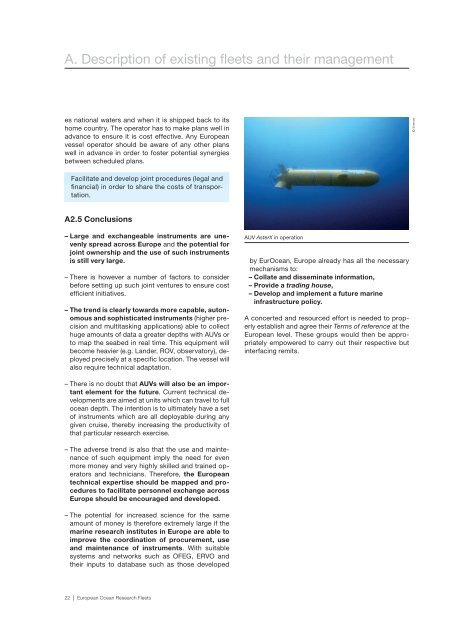European Ocean Research Fleets - uefiscdi
European Ocean Research Fleets - uefiscdi
European Ocean Research Fleets - uefiscdi
Create successful ePaper yourself
Turn your PDF publications into a flip-book with our unique Google optimized e-Paper software.
A. Description of existing fleets and their management<br />
es national waters and when it is shipped back to its<br />
home country. The operator has to make plans well in<br />
advance to ensure it is cost effective. Any <strong>European</strong><br />
vessel operator should be aware of any other plans<br />
well in advance in order to foster potential synergies<br />
between scheduled plans.<br />
© Ifremer<br />
Facilitate and develop joint procedures (legal and<br />
fi nancial) in order to share the costs of transportation.<br />
A2.5 Conclusions<br />
– Large and exchangeable instruments are unevenly<br />
spread across Europe and the potential for<br />
joint ownership and the use of such instruments<br />
is still very large.<br />
– There is however a number of factors to consider<br />
before setting up such joint ventures to ensure cost<br />
efficient initiatives.<br />
– The trend is clearly towards more capable, autonomous<br />
and sophisticated instruments (higher precision<br />
and multitasking applications) able to collect<br />
huge amounts of data a greater depths with AUVs or<br />
to map the seabed in real time. This equipment will<br />
become heavier (e.g. Lander, ROV, observatory), deployed<br />
precisely at a specifi c location. The vessel will<br />
also require technical adaptation.<br />
AUV AsterX in operation<br />
by Eur<strong>Ocean</strong>, Europe already has all the necessary<br />
mechanisms to:<br />
– Collate and disseminate information,<br />
– Provide a trading house,<br />
– Develop and implement a future marine<br />
infrastructure policy.<br />
A concerted and resourced effort is needed to properly<br />
establish and agree their Terms of reference at the<br />
<strong>European</strong> level. These groups would then be appropriately<br />
empowered to carry out their respective but<br />
interfacing remits.<br />
– There is no doubt that AUVs will also be an important<br />
element for the future. Current technical developments<br />
are aimed at units which can travel to full<br />
ocean depth. The intention is to ultimately have a set<br />
of instruments which are all deployable during any<br />
given cruise, thereby increasing the productivity of<br />
that particular research exercise.<br />
– The adverse trend is also that the use and maintenance<br />
of such equipment imply the need for even<br />
more money and very highly skilled and trained operators<br />
and technicians. Therefore, the <strong>European</strong><br />
technical expertise should be mapped and procedures<br />
to facilitate personnel exchange across<br />
Europe should be encouraged and developed.<br />
– The potential for increased science for the same<br />
amount of money is therefore extremely large if the<br />
marine research institutes in Europe are able to<br />
improve the coordination of procurement, use<br />
and maintenance of instruments. With suitable<br />
systems and networks such as OFEG, ERVO and<br />
their inputs to database such as those developed<br />
22 | <strong>European</strong> <strong>Ocean</strong> <strong>Research</strong> <strong>Fleets</strong>

















